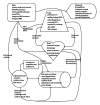Inflammatory signalling associated with brain dead organ donation: from brain injury to brain stem death and posttransplant ischaemia reperfusion injury
- PMID: 23691272
- PMCID: PMC3649190
- DOI: 10.1155/2013/521369
Inflammatory signalling associated with brain dead organ donation: from brain injury to brain stem death and posttransplant ischaemia reperfusion injury
Abstract
Brain death is associated with dramatic and serious pathophysiologic changes that adversely affect both the quantity and quality of organs available for transplant. To fully optimise the donor pool necessitates a more complete understanding of the underlying pathophysiology of organ dysfunction associated with transplantation. These injurious processes are initially triggered by catastrophic brain injury and are further enhanced during both brain death and graft transplantation. The activated inflammatory systems then contribute to graft dysfunction in the recipient. Inflammatory mediators drive this process in concert with the innate and adaptive immune systems. Activation of deleterious immunological pathways in organ grafts occurs, priming them for further inflammation after engraftment. Finally, posttransplantation ischaemia reperfusion injury leads to further generation of inflammatory mediators and consequent activation of the recipient's immune system. Ongoing research has identified key mediators that contribute to the inflammatory milieu inherent in brain dead organ donation. This has seen the development of novel therapies that directly target the inflammatory cascade.
Figures


References
-
- Organ. Procurement and Transplantation Network. Organ by Status, 2011, http://optn.transplant.hrsa.gov/
-
- Fink MA, Berry SR, Gow PJ, et al. Risk factors for liver transplantation waiting list mortality. Journal of Gastroenterology and Hepatology. 2007;22(1):119–124. - PubMed
-
- Banner NR, Rogers CA, Bonser RS, et al. Effect of heart transplantation on survival in ambulatory and decompensated heart failure. Transplantation. 2008;96(11, article 8) - PubMed
-
- Reed A, Snell GI, McLean C, Williams TJ. Outcomes of patients with interstitial lung disease referred for lung transplant assessment. Internal Medicine Journal. 2006;36(7):423–430. - PubMed
-
- De Vleeschauwer SI, Wauters S, Dupont LJ, et al. Medium-term outcome after lung transplantation is comparable between brain-dead and cardiac-dead donors. Journal of Heart and Lung Transplantation. 2011;30(9):975–981. - PubMed
LinkOut - more resources
Full Text Sources
Other Literature Sources

